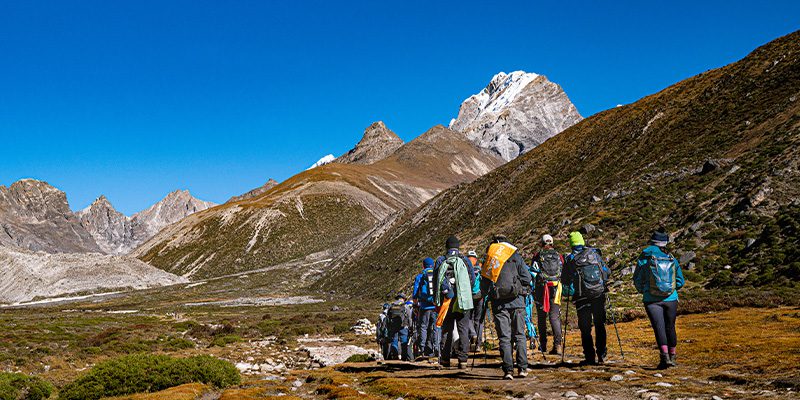
When gearing up for the Manaslu Circuit Nepal, you will need to pack light if you’re going to be able to enjoy adventuring through one of Nepal’s most remote and beautiful areas. [WPSM_AC id=1273] The Manaslu Circuit doesn’t sugarcoat anything – it should be no surprise that carrying a stuffed backpack up and down high mountain passes will occasionally leave you breathless. Overpacking can make you feel weighted down, increase fatigue, and make your journey harder than it needs to be. Smart packing, on the other hand, can be a game changer in the way you experience a place, all the while keeping you safe and ready for every situation.
You need good quality gear (pack-for-4-Season type) that does more than one thing. Dress in layers so you can adjust to the mountain’s volatile weather. Pack wicking baselayers, the insulating jacket of fleece or down, and a waterproof shell. Instead of packing weeks’ worth of clothes, pack just a few quick-dry pieces that can be washed and rinsed out on rest days. Stay clear of the bulky stuff—lightweight, streamlined versions of the essentials are best whenever possible.
Limit your footwear to one solid and broken-in pair of hiking boots and a lightweight pair of sandals or camp shoes. Accessories should be kept to a minimum: hat, gloves, buff, sunglasses, and headlamp. Toiletries need to be minimized as well and only packed in travel-sized quantities: basic, such as biodegradable soap, toothbrush, toothpaste, sunscreen, lip balm.
Your first aid kit needs to be lightweight, but it must also do the job, with basics like bandages, antiseptics, blister treatment, pain relief, and altitude sickness tablets. Organize your health care items with a small and water-resistant backpack, and don’t leave without a refillable water bottle or hydration bladder, along with purification tablets or a filter. It will enable you to make sure you are staying hydrated without the added water weight.
Too many electronics are a big no-no. A power bank can also be useful, as few charging opportunities exist on the Manaslu Circuit. It may be possible to navigate with a smartphone that has offline maps, or bring along a small GPS. Most teahouses on the trail do not provide free electricity or internet — keep devices to a minimum.
You’ll need a good-quality 40–50 liter trekking backpack that fits you well and has adjustable straps and a rain cover. If you are using porters, you can separate your load into a small daypack and a duffel for your porters to lug. Stuff your daypack with daily essentials, including water, snacks, camera equipment, a rain jacket, and any valuables.
“Packing light for the Manaslu Circuit Trek” doesn’t equate to arriving unprepared—it’s about selecting wise, weight-conscious gear to keep you safe and comfortable while minimizing weight. By going light, you’ll eat up less energy, minimize your potential for injury, and fully enjoy the awesome Himalayan views. If you pack smart, you will be able to concentrate on the trail, the views, and what the amazing Manaslu region has to offer you.
Why You Should Pack Light For the Manaslu Circuit Trek?
Travelling light for the Manaslu Circuit is not only a matter of convenience but also a matter of how well you will be able to manage the trek and how comfortable you will be. The Manaslu area includes steep climbs and high mountain passes, including Larkya La (5,106 meters), and long walking days. Being overweight can slow you down, make you more tired, and make your injuries , particularly the ones to your knees and ankles, more likely. A lighter pack also facilitates acclimatization to altitude because your system has to work less on every basic movement.
Given the remote setting of the Manaslu region, you should keep all the items in your bag as functional and purpose-driven as possible. There are fewer shops and amenities than on more commercial treks, such as Everest Base Camp, so saving space and minimizing weight is essential. An efficient pack also means you will make faster transitions between teahouses, and if you hire a porter, your luggage will be easier for them to manage.
You want to move quickly, without your pack rhythm with you in motion, attention on your surroundings, and energy reserves for an incredible mountain pass. In unpredictable Himalayan weather, being able to quickly grab some gear without digging through an overstuffed bag is also a big bonus. The result is a safer, more enjoyable trekking trip in the stunning surroundings of Manaslu.
What is the Ideal Backpack Capacity for the Mathe Naslu Circuit Trek?
Pack Size for Manaslu Circuit Trek: Selecting the correct backpack is one of the most important factors to pack light and hike effectively in the Manaslu Circuit. For the majority of trekkers, 40 to 50 litres makes a great backpack. It’s also a great size to put in a gym bag or under a plane seat and will fit everything you need, your clothing and personal items, but equally won’t allow for overpacking. You are likely not hiring a porter, and so this backpack will be your main piece of luggage: comfort and fit are vital.
Seek out a pack with adjustable shoulder straps, a cushioned hip belt, and an internal frame that will help balance the load. And extras such as external pockets, gear loops, and a rain cover add convenience and protection to your assorted gear in any weather.
If you’re considering hiring a porter — and that’s something to consider, especially if you don’t have many days of high-altitude trekking in your legs — it makes sense to have two relatively small bags: a relatively voluminous duffel bag (that the porter carries when not in action) and a 20-30 liter daypack, which contains everything you need during the day. Your daypack should contain stuff like water, munchies, rain gear, a camera, personal ID, and maps.
Ultimately, avoid large backpacks because people are more likely to pack things they don’t need when they have the extra space. Keep it simple and go for a backpack that offers the right amount of storage as well as support. A good backpack makes sure your load is light, your stuff is organized, and your back is not sore from everything on the trail.
How do You Choose Clothes to Maximize the Weight?
Manaslu Base Camp Trek It’s important to make good decisions regarding clothes when it comes to keeping the weight down on the Manaslu Circuit Trek! The trick is to layer up with lightweight, moisture-wicking fabrics that can be shed in variable weather. The trek covers elevations from 700 meters to 5,000 meters and higher, so temperatures can fluctuate greatly in the course of a day.
You should have a “system” of 3 layers: The base layer: the thermal top and bottom, a mid-layer: The fleece or light down jacket, and a shell layer: The waterproof windproof jacket and pants. Carry just 2–3 quick-drying shirts, 1–2 pairs of trekking pants, and 1 set of base layers for cold nights. These can be washed and worn on rest days.
Escape cotton clothing, which holds water and takes a long time to dry. Opt for synthetic or merino wool fabrics for better performance and packing. Bring one light pair of insulated gloves, a hat, and a buff or neck gaiter for warmth and sun protection.
Footwear: 1 pair of trekking boots which should be well worn-in and waterproof, of 1 pair of camp shoes or sandals. When you layer effectively and reuse items thoughtfully, you stay warm and dry without overpacking. Smart clothing decisions keep your pack light and your body comfortable from the beginning of the trail up to the top of the Manaslu Circuit.
What Toiletries and Personal Items Should You Pack?
Toiletries and Personal Hygiene to Carry for Manaslu Circuit: Make sure you keep your toiletries and personal items to a minimum, and eco-friendly. Since teahouses will often offer only the basics, and in remote areas, access to running water can be scarce, you’ll need to keep things simple and efficient.
Begin with mini-bottles of biodegradable soap, shampoo, and toothpaste. Carry a small toothbrush, lip balm with SPF, and a quick-drying pack towel. Wet wipes are useful for your daily hygiene when showers aren’t accessible, and hand sanitizer can help you avoid getting sick on the trail.
You will want a minimum first aid kit. She should carry plasters for blisters, antiseptic cream, a painkiller, and medicine for altitude sickness (consult your GP about chewable acetazolamide/Diamox). Sunscreen (SPF 30), insect repellent, and a tiny mirror are also good. Remember nail clippers, tweezers, and a small comb or brush.
Everything should fit into a lighter toiletry or dry bag. Save space and weight by decanting liquids into smaller containers. Don’t carry full-size bottles or multiples. By making judicious selections among your toiletries and opting for lightweight packaging, you keep clean without adding weight to your backpack—something you need for a light, effective packing strategy on the Manaslu Circuit.
Do You Need Trekking Poles for the Manaslu Circuit Trek?
Yes, to bringing trekking poles for the Climb Manaslu, even if you are going ultra-light. The trek involves climbing a fairly hard ascent, climbing a difficult pass, and walking a long time through the rough road of Larkya La Pass. Lightweight, foldable trekking poles can reduce strain on your knees and provide better balance, especially when you have a backpack on your back and are making your way over icy, loose, or rocky sections of the trail.
Hiking poles also relieve some of the stress on your knees, encourage you to establish and maintain a rhythm, and make it easier to avoid potential injury. They work especially well at higher altitudes, where oxygen is scarce and every step comes with a heft you just can’t quite get out of breath. Seek out poles constructed from light and strong materials — carbon fiber or aluminum. Being adjustable or foldable in design, they can be carried on your backpack as well when you don’t need them.
Though they do contribute a small amount of extra weight, the pros far outweigh the cons, particularly on strenuous days. For many trekkers, poles become indispensable after days on the trail. They support and absorb shock through your stride, which makes walking more efficient and less punishing on the body, key when you’re trying to pack light and trek smart on one of Nepal’s most demanding high-altitude circuits.
What Is the Best Kind of Sleeping Bag for the Manaslu Circuit?
Selecting the best sleeping bag for the Manaslu Circuit Trek is crucial as the temperatures fall below the freezing point at the higher elevations. Teahouses offer rudimentary bedding, the cleanliness and heat of which can be far from acceptable at altitudes above 3,500 meters. To keep warm and safe without over-packing, pack a light, space-saving sleeping bag rated for -10°C to -15°C (14°F to 5°F) and a sleeping bag liner.
It should be filled with down, because it gives the best warmth-to-weight ratio and packs small. But synthetic options stand up better to moisture — a consideration if your gear were to become wet. When you’re reading sleeping bags, try to find one that has a mummy shape, a hood, and draft collars to keep heat in better.
For even more compressibility, try a compression sack to minimize the bag’s bulk inside your pack. You can also add a silk or fleece liner for added warmth and hygiene that won’t bulk you up.
Quality of Sleep A good night’s sleep is essential when you’re hiking, and this is where the contents of your bag are going to work the hardest. It is one of the most critical pieces you will invest in when trying to keep warm and pack light on the Manaslu Circuit.
How Do You Reduce Food and Snacks Yet Still Keep Energized?
Manaslu Circuit Trekking There is food available at teahouses along the Manaslu Circuit, which means there is no requirement to carry large amounts of meals or bulky cooking equipment. That said, it is important that you bring some lightweight, high-calorie snacks to stay energized on long trekking days, especially in between meals or whilst ascending at altitude.
Pick small, nutrient-packed snacks such as energy bars, trail mix, nuts, dried fruit, and even a little dark chocolate. Not only do they travel well, but they also provide easily digestible, fast energy. Don’t bring snacks that have lots of extra packaging or bulk – repackage in ziplock bags for space saving.
Do not need more than a few other snacks per day, so plan according before trekking days. Make lightweight, spoil-resistant food your priority. Don’t use anything moist or heavy like canned goods.
Electrolyte tablets or rehydration salts are also a good idea to have available. They’re lightweight, fit easily into any bag, and can be used to replenish minerals lost during hard sections or on hot days.
With some thoughtful snacking and teahouse meals, you’ll remain energized, and your pack weight low — and in turn, enjoy better sustenance and comfort through your trek.
What Papers and Permits Should You Have, and How Do You Protect Them?
Manaslu Circuit Trekking needs some authorized permits, and protecting them is most important. You will also require the Manaslu Restricted Area Permit (RAP), the Manaslu Conservation Area Permit (MCAP), a nd the Annapurna Conservation Area Permit (ACAP). Filling out these papers is compulsory, and they need to be submitted at various checkpoints in the circuit.
Carry both hard copies and electronic copies of your permits and important documents (passport, visa, travel insurance). Keep the printed section in a waterproof document pouch or ziplock bag to shield it from the rain or snow. Keep this gear in your daypack, not in a duffel that’s carried by a porter, as you’ll need to display it often.
Your passport should be valid for a minimum period of 6 months at the time of stay. You should also carry a couple of passport-sized photos for anything unexpected , like SIM card registration or backup permits.
In order to avoid any delays or hassle with the local authorities and to make your trip of trekking trip enjoyable and effort-less, keep all your paper documents safe, dry, and well organized, with you to show at the time when required. It may be a tiny piece of your gear, but it is key to compliance and safety.
How to Carry Enough Water but Not Too Much
Water is key on the Manaslu Trekking, but hauling several liters at a time is wasted pack weight. Forget lugging the weight of heavy water bottles – opt for a reusable water bottle or hydration bladder and combine with purification tablets, a UV filter, or a small water filter. With this style, you can refill in the local streams or teahouse taps without the weight of bottled water!
There are plenty of water sources on the route, though they are not always potable, untreated. A minimalist filtration system — a SteriPEN or Sawyer Mini — purifies water in minutes and takes up little space in your pack. Or, iodine tablets and chlorine drops are small and effective, although they can alter taste.
Bring 1 to 2 liters at a time and refill when necessary. This lightens the load of the pack while keeping you hydrated. It’s also good for the environment, with the potential to cut down on the plastic waste in the fragile Himalayan ecosystem.
Save room for hydration that is safe. While it’s not always possible to lighten your load, using purification tools and planning the timing of refills means keeping your pack light, your body healthy, and a beverage in hand on the grueling hike.
How Do You Pack Light While Still Being Prepared for Emergencies?
It’s a balancing act between having a light pack while still being prepared for emergencies. Think ‘multi-use’ and the basic essential safety items without bulk. Begin with a small first aid kit with blister care, antiseptics, bandages, pain relievers, and altitude sickness medicine. Throw in a couple of basic survival items with the following: a headlamp and extra batteries, a whistle, and an emergency blanket; minimal weight, with the potential of saving a life.
Bring a light rain poncho or waterproof shell, even if hiking in a dry season. Pack duct tape or fix-it kits for torn gear or broken zippers, and a little pocket-size multi-tool for patching things up. These products provide that added security and peace of mind when out backpacking.
Also, bring along a basic phone with free, offline GPS maps or a light satellite communicator if you are trekking without a guide. Ensure that your emergency contacts, insurance information, and evacuation guidelines are easy to locate, both digitally and on paper.
This being prepared doesn’t mean packing everything — only what could make a difference. Because you opted for the compact, no-nonsense essentials of your safety tools, you’re ready for shit to get real without forgoing the super-light approach required for trekking the rugged, high-altitude terrain of the Manaslu Circuit.
What to take on the Manaslu Circuit?
Packing for the Manaslu Circuit Trek is a delicate balance of minimalism and preparedness. It’s a remote, high-altitude trek, and your gear needs to be versatile, sturdy, and weather-appropriate. Wear clothes according to the layering system of a moisture-wicking base layer, such as merino; a warming mid-layer (such as a fleece); and a waterproof outer shell. Bring one or two pairs of quick-drying trekking pants, 2–3 shirts, a warm hat, gloves, and a buff or neck gaiter. A good sleeping bag that will be rated to around -10 is essential for higher elevations where nighttime can get below freezing.
Manaslu Peak Footwear: Durable, waterproof hiking boots and lightweight sandals for use around camp in the evening. Use a 40–50 liter backpack with support and a 20–30 liter daypack if you are using a porter. Toiletries should be small and biodegradable, with sunscreen, lip balm, and hand sanitizer. Carry a first aid kit, blister remedies, tablets to ward off altitude sickness (with a doctor’s approval), and water purifiers, such as tablets or a filter. A couple of trekking poles, a headlamp, a power bank, and rain cover are also indispensable.
Pack photocopies of permits (RAP, MCAP, ACAP), your passport, and travel insurance policy covering high-altitude trekking. With intelligent preparation, even as a solo trekker, you can travel light and have all the right stuff with you to make sure you have an enjoyable and safe hike through the Manaslu region.
Mount Manaslu Circuit Trek- How do I prepare for it?
Good preparation is important to successfully achieve the Manaslu Circuit Trek. Quite a demanding trek that requires adequate physical fitness and a strong mind, start working out at least 2- 3 months prior to your trek. Prioritize cardiovascular health through activities such as running, hiking, or cycling, and incorporate strength training for your legs, back, and core. Simply carry out long hikes with a heavily loaded backpack, and one is good to go.
As important is the logistical planning you will do. Get all the permits – the Manaslu Restricted Area Permit (RAP), the Manaslu Conservation Area Permit (MCAP), and the Annapurna Conservation Area Permit (ACAP). Arrange your transport to Soti Khola (start) and back from Dharapani or Besisahar out of Kathmandu. You are required to employ a licensed guide to trek in these restricted areas, while a porter is strongly recommended.
Pack high-altitude and ever-changing weather gear, including warm layers, a -10°C sleeping bag, trekking boots, poles, and a good backpack. Carry some cash, as there are no ATMs on the trek. Make sure your travel insurance covers trekking at or above 4,000 meters and emergency evacuation.
Lastly, mentally prepare yourself for basic facilities, simple food, and remoteness. Open-mindedness, strong physical fitness, and the right equipment are the basics of a well-enjoyed Manalsu Circuit trek.
Is Manaslu Circuit Trek Safe?
Yes, it’s safe to do the Manaslu Circuit Trek if you are adequately prepared, take experienced guides, and have the right gear. And while it’s more remote and less developed than Everest or Annapurna, its infrastructure has come a long way in recent years. There are refuges along the way with accommodation and meals, and the Nepalese have a reputation for their hospitality.
But some risks continue. Acute mountain sickness can pose a substantial threat, particularly around Larkya La Pass (5,106m). The good news is that to avoid harm, slow ascent, acclimatization day, and lots of water should all feature in your plans. Guides are trained to identify symptoms and can take swift action if necessary. It is not legal to climb the peak without hiring a registered guide, and doing so contributes to safety by ensuring good route management and communication in the event of an emergency.
A section of the trail can be hard and may have slides and a narrow tread. Trekking poles and solid boots decrease the chance of injury. The weather in the Himalayas is capricious; don’t forget to take warm clothes and waterproof ones.
And make sure your travel insurance includes climbing at high altitudes and helicopter evacuation. With proper preparation, the Manaslu Circuit can be a spectacular, off-the-beaten-track, exciting, and safe trek in the Himalayas for those in search of perhaps the road less travelled trek with great views, trails, culture, and, of course, people.
Difficulty of the Manaslu Circuit Trek.
The Manaslu Mountain is considered moderate to strenuous, depending on your level of fitness, trekking experience, and ability to adjust to the altitude. Covering around 177 km (110 miles) and crossing the Larkya La Pass (5,106 meters/16,752 feet), it includes long days walking, tough vertical and difficult weather.
Typically, you will walk 6-8 hours a day, where the terrain is rugged and uneven, you cross suspension bridges, rocky trails, and high alpine areas. What makes Manaslu more challenging than other treks is that you don’t really have roads, especially in the upper part of the Manaslu trek. Lodging is rudimentary, and there are no upscale lodges like in the Everest or Annapurna areas.
At high altitude, the effort of exercise is accentuated as well, above 3,500 m. To counteract this, rest days and gradual res, or slow movements up, are incorporated in the typical itinerary. A licensed guide and porter not only make the trek easier and safer, especially near the high pass.
Though difficult, the journey is possible for those who have good health, a strong mentality, and are well-prepared. The payoffs — unspoiled landscapes, remote villages, and a sense of serenity — combine to make it one of Nepal’s most rewarding off-the-beaten-path adventures.




